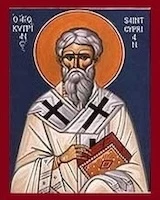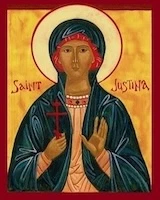Orthodox Marriage
"There is nothing more precious than to love a wife and to be loved by her" (St John Chrysostom)
Marriage is generally seen as the joyous, loving commitment of a man and a woman to live their life together; this commitment is often sealed in a civil ceremony. The Orthodox Church regards marriage as a sacrament and speaks of it as a "mystery". What does it mean to say that marriage is a "mystery?" To put simply, we call marriage a "mystery" because something mystical, something that cannot be explained in merely rational terms happens when a man and a woman come before God and seek His blessing to be joined together, to "become one flesh." The bride and groom are brought into the sacred dimension of life as God acts mysteriously, that is invisibly, to draw them into His Kingdom. The life which the couple have chosen to share together is integrated into the sacramental life of the Church. From the beginning, God Himself instituted the Holy Mystery of marriage and it is confirmed by Our Lord Jesus Christ. "So God created man in his own image, in the image of God he created him; male and female he created them. And God blessed them, and God said to them, "Be fruitful and multiply, and fill the earth . . .Therefore a man leaves his father and his mother and cleaves to his wife, and they become one flesh." (Genesis 1:27-28a, 2:24) "For this reason a man shall leave his father and mother and be joined to his wife, and the two shall become one flesh". So they are no longer two but one flesh. What therefore God has joined together, let not man put asunder." (Matthew 19: 5-6). One could say that in an Orthodox perspective, there are not two but three in a marriage: the man, the woman, and Christ who joins them together and supports them in their married life. Marriage is a sacramental means of unity between man and woman. This unity between husband and wife is an image of the relationship between Christ and his Church.
Preparation for marriage is twofold, inner and outer. It is just as important for the couple to prepare themselves spiritually as they get busy organising the wedding-dress, crowns, cars, photographers, the reception etc. The bridal pair should be aware that marriage is not celebrated during certain days of the year. It is very important that they consult their priest over the choice of the wedding-day before making other arrangements. In general, and especially in the case of mixed marriages, it is advisable to allow for a good length of time for preparation. It is recommended that the bridal pair talk to the priest, attend Church services. They should also get a copy of the marriage-service and familiarize themselves with it. The priest may advise fasting and confession and partaking of the Holy gifts, as part of the preparation. A more formal aspect of the preparation is the paperwork. You should arrange a meeting with the priest to fill in the necessary forms and for advice on acquiring the required documentation. You will also need to go to your local registry office for the purposes of the civil ceremony. According to the laws of England and Ireland, the civil ceremony must take place before or during the Orthodox wedding. Please contact your priest well in advance to make the appropriate arrangements.
- Choosing Sponsors Because marriage is a sacrament of the Church and not merely a legal ceremony, the sponsors must be Orthodox Christians and married in the Orthodox Church.
- Offering Churches vary in what they require by way of financial contributions. Though this is often described as "fees", it should be seen as a thanksgiving offering to God to mark the joyous event.
The Marriage service
- The Betrothal O Lord our God, who once betrothed yourself to the Church from the nations as a pure virgin, bless this betrothal, and unite and preserve these servants of yours in peace and concord. The marriage service begins with the betrothal. The priest prays for God"s blessing upon the couple, asking that they may live in unity and harmony: Confirm them with the holy unity that comes from you. For it was you who in the beginning created male and female, and it is by you that woman is linked to man as a helper and for the continuation of the human race ...
- The Crowning After the betrothal, we have the joining of hands, the crowning and the sharing of the common cup. The priest joins the hands of the couple together, saying, "do you, Master, now send forth your hand from your holy dwelling, and link your servant (name) and your servant (name), because it is by you that a wife is linked to her husband. Yoke them together in likeness of mind. Crown them into one flesh". This action of the priest joining the hands of the couple is a sign that it is the Church that makes the marital union of man and woman a reality. The joining of hands is followed by the crowning. This part of the service overflows with joy and is rich in symbolism. "Crown them with glory and honour," so prays the priest as the couple are crowned. This associates the crowning with Christ"s return to heaven in "glory and honour" and his dominion over all things.
- The Common Cup In the early Church, the couple"s marriage was fulfilled in their receiving their communion together at the Divine Liturgy. These days most marriages are celebrated outside the Divine Liturgy. So, a cup of wine is blessed by the priest and is offered to the couple as a reminder of the common life which they will share together. Though this is not the communion cup, it still serves as a reminder of the Eucharistic partaking of Christ"s mystical body and blood. As the Priest gives the cup to the couple, he chants, "I will take the cup of salvation and I will call on the name of the Lord."
Rings are blessed and exchanged. The prayer that follows recalls various episodes in the Old and New Testaments where a ring figures as a pledge of God"s love.
The crowns represent the "unfading crown of glory" promised to the faithful. The prayers of blessing that evoke the saints point to the Cross as the road to kingship. Martyrs are mentioned, and the crowns are symbols of martyrdom. This association of martyrdom with marriage is a reminder of the trials and tribulations of married life. However, the reference to martyrdom is not a "morbid" invocation of suffering, but a solemn yet joyful way of indicating what distinguishes a Christian marriage from a mere partnership.
The Epistle and Gospel readings emphasize the close relation between marriage and life in the Church. The reading from St. Paul to the Ephesians (5: 20-33) spells out how the inspiration for mutual love and respect in marriage is Christ Himself. The reading from the Gospel of St. John (2:11) which describes Christ"s presence at the wedding at Cana in Galilee and the miracle of transforming water into wine, reminds us of the Divine Liturgy, where Christ offers Himself to us in his body and blood. This gospel reading prepares us for the next phase of the ceremony.
Then follows a procession, called Isaias's dance. It is more of a procession than dance and is called Isaias' because as the procession begins, his prophecy is chanted: "the Virgin has conceived and given birth to a Son, Emmanuel, who is both God and man. Orient is his name, whom we magnify as we call the Virgin blessed." The bridal pair, together with the priest, circle the table as the angels do around God. This procession is also performed during the ordination of priests and deacons, so marriage is identified as a sacred vocation. The whole service places marriage in the context of salvation, and keeps us in tune with the core beliefs and hopes of being Christian. The "nuptial blessing" is addressed to the Trinitarian God, stressing the unity under which the couple are brought together.
May Father, Son and Holy Spirit, the all-holy, consubstantial Trinity, origin of life, the one Godhead and Kingship, bless you and grant you long life, fair offspring, progress in life and faith, and fill you with every good thing on earth, and count you worthy of the promised good things of the enjoyment [of heaven], at the prayers of the Mother of God and of all the Saints.
"Be fruitful and multiply, and fill the earth..."
Family, while not the sole purpose of marriage, is an extension of it, and the natural expression and fruit of marital love. In the marriage service, children are mentioned several times. It is therefore clear that married life means family life. This is not to say that there are no exceptions or that a marriage ceases to have any value if the couple are unable to have children. At the same time, children are not to be avoided for selfish reasons.
The question of submission
In Ephesians 5: 33, St Paul offers a mini-homily to married couples. He says: "be subject to one another out of reverence for Christ". This has been often misunderstood and misused; and, in our times of women's liberation it has provoked a great deal of protest. Obedience extracted tyrannically is a symptom of sin and should be condemned. What St Paul recommends is mutual respect and love. The Christian ideal of marriage is a Christ-centred life that ensures a highly civilized, sophisticated, sensitive relationship that prepares the couple for the Kingdom of God here and now. St Paul sees the married couple as a symbol of the union between Christ and His bride, the Church. "This mystery is a profound one, and, I am saying that it refers to Christ and the Church" (Ephesians 5: 32). St Paul begins by addressing the women, stating how they should be subject to their husbands as the Church is to Christ. With equal force, his words are addressed to husbands: "Husbands, love your wives, as Christ loved the church . . ." (Ephesians 5: 25). And how did Christ love the Church? He humbled Himself, suffered and died for her; As St Paul puts it, Christ "gave himself up for her".

